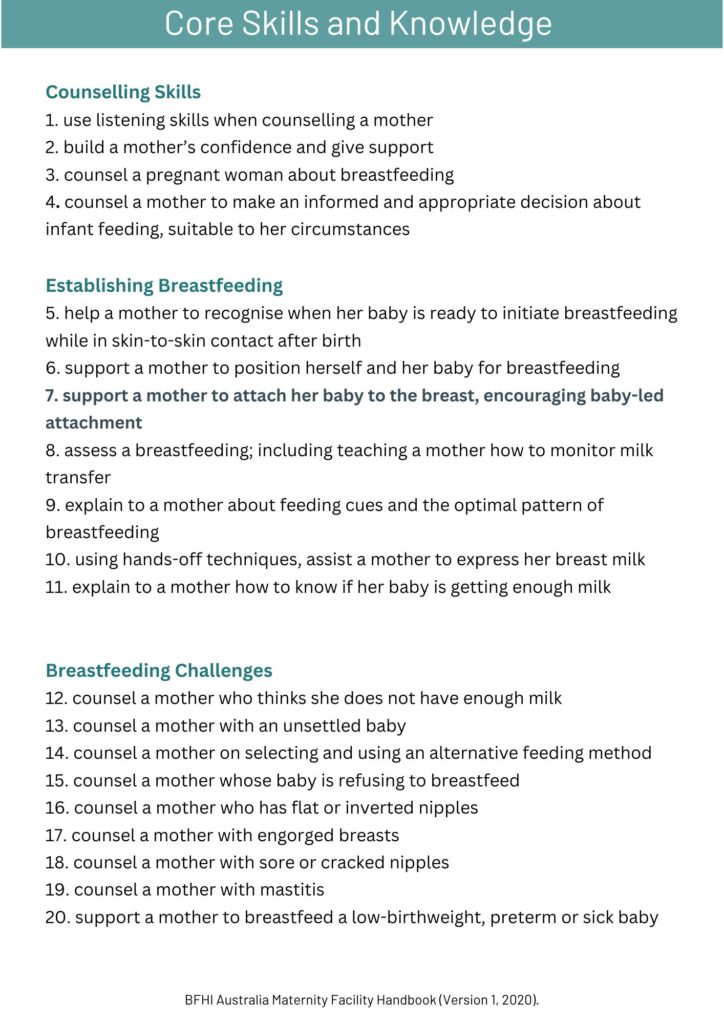Why I Became a BFHI Assessor
When it comes to breastfeeding, the right support can make all the difference. Over the years, I’ve seen how often new mums face challenges not because they lack determination, but because the system lets them down. That’s why I’m so passionate about the Baby Friendly Health Initiative (BFHI).
In Australia, BFHI doesn’t just apply to hospitals—it also includes community settings like child health clinics and lactation services. It’s about ensuring that every family, no matter where they are, receives care that’s grounded in evidence and geared toward breastfeeding success.
Sadly, here in Perth, WA, only two hospitals are BFHI accredited. What I see in non-accredited facilities often falls far short of what’s needed to truly support breastfeeding families.
One of the BFHI’s key guidelines is Step 4: Facilitate immediate and uninterrupted skin-to-skin contact and support mothers to recognise when their babies are ready to breastfeed, offering help if needed. This step is foundational to successful breastfeeding, yet it’s one of the most inconsistently implemented—especially for babies born via caesarean.
What Are the BFHI 10 Steps?
The Ten Steps to Successful Breastfeeding form the foundation of the BFHI. These evidence-based practices are designed to ensure that every family receives consistent, high-quality care to support breastfeeding.
Critical Management Procedures
Step 1a: Have a Written Infant Feeding Policy that is Routinely Communicated to Staff and Parents
Step 1b: Comply fully with the International Code of Marketing of Breastmilk Substitutes and Relevant World Health Assembly resolutions
Step 1c: Establish Ongoing Monitoring and Data-Management Systems
Step 2: Ensure that staff have sufficient knowledge, competence, and skills to support breastfeeding
Key Clinical Practices
Step 3: Discuss the importance and management of breastfeeding with pregnant women and their families
Step 4: Facilitate immediate and uninterrupted skin-to-skin contact and support mothers to recognise when their babies are ready to breastfeed, offering help if needed
Step 5: Support mothers to initiate and maintain breastfeeding and manage common difficulties
Step 6: Do not provide breastfed newborns any food or fluids other than breastmilk, unless medically indicated
Step 7: Enable mothers and their infants to remain together and to practise rooming-in 24 hours a day
Step 8: Support mothers to recognise and respond to their infants’ cues for feeding
Step 9: Counsel mothers on the use and risks of feeding bottles, teats, and pacifiers
Step 10: Coordinate discharge so that parents and their infants have timely access to ongoing support and care
Step 4: Supporting the Baby’s Natural Feeding Instincts
A big part of Step 4 is about trusting and supporting a baby’s innate ability to find the breast and initiate breastfeeding on their own. Skin-to-skin contact helps facilitate the newborn’s natural rooting reflex, which is key to imprinting the behaviours of looking for the breast, self-attaching, and suckling.
Here’s how it works: when placed on their mother’s chest immediately after birth, babies enter a sequence of innate pre-feeding behaviours. This often begins with quiet observation and progresses to seeking the breast, attaching, and feeding. The process is gentle and unhurried, allowing the baby to lead the way.
Although the BFHI specifies that skin-to-skin contact should continue for at least an hour, research shows that most healthy, full-term babies need about an hour to complete this natural sequence. In one study, the median time for babies to begin suckling was 62 minutes, with 25% starting by 43.5 minutes and 75% by 90.3 minutes. This evidence underscores the importance of patience and uninterrupted skin-to-skin contact during this critical time, which may be longer than 1 hour (Brimdyr et al 2020).
In fact, extended skin-to-skin time can be a game-changer.
This is where Nils Bergman’s work on zero separation comes in. He highlights how the first 1000 minutes after birth (about 16 hours) are critical for setting the stage for lifelong health and development. According to his research:
• Extended skin-to-skin reduces stress for the baby by stabilising cortisol levels, which supports their brain development, particularly in areas related to emotional regulation and bonding.
• It helps regulate the baby’s temperature, breathing, and heart rate in a way no machine or intervention can replicate.
• Skin-to-skin contact enhances the baby’s immune system by seeding their microbiome with mum’s beneficial bacteria.
• It increases oxytocin—the “love hormone”—for both mum and baby, deepening their bond and supporting mum’s recovery after birth.
• It boosts breastfeeding success by keeping the baby’s feeding reflexes active and stimulating mum’s milk supply.
Extended Skin to Skin also Benefits the Parental Brain
The benefits of skin-to-skin aren’t just for the baby—it’s transformative for parents too. For mums, prolonged skin-to-skin contact stimulates the release of oxytocin and prolactin, hormones that foster feelings of love, protectiveness, and calm. These hormonal shifts also help reduce stress and lower the risk of postnatal depression. Oxytocin doesn’t just help with emotional bonding—it also supports physical recovery by reducing postpartum bleeding and promoting healing.
Skin-to-skin can also help mothers feel more confident in their ability to breastfeed and care for their baby. This connection is reinforced through the baby’s cues and behaviours, which signal to the mother’s brain that she is meeting her baby’s needs. It’s not just about instinct—it’s about the neurobiological changes happening in the maternal brain that help build this bond.
A Hands-Off Approach
One of the beautiful aspects of Step 4 is its hands-off philosophy. The midwife’s role isn’t to rush or force the baby onto the breast—it’s to support the mother in recognising and responding to her baby’s feeding cues.
Babies are remarkably capable of finding their way to the breast when given the time and space to do so. This approach helps establish a positive breastfeeding relationship right from the start, building confidence for both mum and baby.
When mothers are empowered to trust their baby’s instincts and their own, it sets the tone for a breastfeeding journey built on mutual confidence and connection.
The Link Between Step 2 and Step 4
I believe one of the reasons Step 4 is so misunderstood and poorly implemented is because Step 2—ensuring all staff have sufficient knowledge, competence, and skills—is often not done properly. This includes the 20 Core Skills and Knowledge that equip staff to understand the science behind skin-to-skin contact, recognise the baby’s innate feeding cues, and support hands-off attachment.
When staff lack this training, they may unintentionally disrupt the natural process of skin-to-skin and self-attachment by over-intervening or rushing mothers and babies. This gap in knowledge and skills not only undermines Step 4 but can have a ripple effect on the breastfeeding journey as a whole.
Proper training equips staff with the confidence and expertise to support mothers in a way that aligns with evidence-based practices. Without it, even the best intentions can fall short.

Why I’m Committed to Step 4
Becoming a BFHI assessor allows me to advocate for practices like Step 4 that are proven to make a real difference. When hospitals embrace uninterrupted, hands-off skin-to-skin care, they’re not just supporting breastfeeding—they’re empowering families to start their parenting journey with trust, confidence, and connection.
Even if a woman isn’t birthing in a BFHI-accredited facility, she can still educate herself and ask for evidence-based practices that support breastfeeding. This is why I recommend not just creating a birth plan, but also a breastfeeding plan—regardless of how a woman plans to birth her baby. Knowing what to ask for and having a clear vision of the care you want can help ensure that your breastfeeding journey gets off to the best possible start.
And don’t be afraid to go beyond the “minimum.” Whether it’s 2 hours of skin-to-skin contact or 16 hours, the more time you and your baby spend together, the greater the benefits. Not only does it support your baby’s development, but it also profoundly impacts your brain as a parent, strengthening your bond, boosting your confidence, and setting the stage for a lifetime of connection.
When we trust this incredible process, the results are nothing short of amazing.
References
BFHI Australia. (2020). BFHI Australia Maternity Facility Handbook (Version 1, 2020). Baby Friendly Health Initiative, Australia. ISBN 978-1-925358-07-0. Updated 2020 incorporating the revised World Health Organisation (WHO) & UNICEF Global Standards for BFHI.
Brimdyr K, Cadwell K, Svensson K, Takahashi Y, Nissen E, Widström AM. The nine stages of skin-to-skin: practical guidelines and insights from four countries. Matern Child Nutr. 2020 Oct;16(4):e13042. doi: 10.1111/mcn.13042. Epub 2020 Jun 16. PMID: 32542966; PMCID: PMC7507317.



